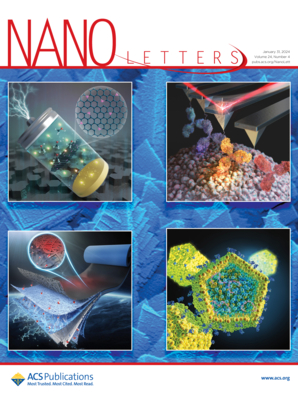Cascade Production of In Situ Oxygen and Singlet Oxygen from Self-Assembled Nanophotosensitizer for Anti-Hypoxic Photodynamic Therapy
IF 9.6
1区 材料科学
Q1 CHEMISTRY, MULTIDISCIPLINARY
引用次数: 0
Abstract
Photosensitizers (PSs) capable of in situ oxygen (O2) production are attractive for overcoming hypoxia in photodynamic therapy (PDT). However, these PSs generally require multiple components and complex fabrication procedures, preventing their clinical translation. Herein, we develop a single-component nanophotosensitizer via simple self-assembly that enables cascade production of in situ O2 and singlet oxygen (1O2) for superior antibacterial PDT (aPDT). Perylene tetracarboxylic acid (PTA) molecules self-assemble into nanophotosensitizers (PTA NPs). Mechanism studies reveal dual functionality of PTA NPs due to their antiparallel-displaced π–π stacking. Aggregated PTA molecules undergo intermolecular electron transfer to yield substantial photogenerated holes, while unimolecular PTA undergoes intersystem crossing to produce triplet PS (3PS*). These holes effectively oxidize water into O2 in situ, which then participates in downstream photosensitization with 3PS* to yield 1O2. This cascade reaction affords PTA NPs with continuous O2 supply and efficient 1O2 production, enabling a 63.07% higher antibacterial rate compared with the clinical antibiotic vancomycin.

自组装纳米光敏剂级联制备原位氧和单线态氧用于抗缺氧光动力治疗
在光动力治疗(PDT)中,能够原位产氧的光敏剂(ps)在克服缺氧方面具有很大的吸引力。然而,这些ps通常需要多个组件和复杂的制造过程,阻碍了它们的临床转化。在此,我们开发了一种单组分纳米光敏剂,通过简单的自组装,可以级联生产原位O2和单线态氧(1O2),用于卓越的抗菌PDT (aPDT)。苝四羧酸(PTA)分子自组装成纳米光敏剂(PTA NPs)。机理研究揭示了PTA NPs由于其反平行位移π -π堆叠而具有双重功能。聚集的PTA分子通过分子间电子转移产生大量的光生空穴,而单分子PTA通过系统间交叉产生三重态PS (3PS*)。这些孔在原位有效地将水氧化成O2,然后与3PS*参与下游光敏反应,产生1O2。这种级联反应使PTA NPs具有持续的O2供应和高效的O2生产,与临床抗生素万古霉素相比,抗菌率提高了63.07%。
本文章由计算机程序翻译,如有差异,请以英文原文为准。
求助全文
约1分钟内获得全文
求助全文
来源期刊

Nano Letters
工程技术-材料科学:综合
CiteScore
16.80
自引率
2.80%
发文量
1182
审稿时长
1.4 months
期刊介绍:
Nano Letters serves as a dynamic platform for promptly disseminating original results in fundamental, applied, and emerging research across all facets of nanoscience and nanotechnology. A pivotal criterion for inclusion within Nano Letters is the convergence of at least two different areas or disciplines, ensuring a rich interdisciplinary scope. The journal is dedicated to fostering exploration in diverse areas, including:
- Experimental and theoretical findings on physical, chemical, and biological phenomena at the nanoscale
- Synthesis, characterization, and processing of organic, inorganic, polymer, and hybrid nanomaterials through physical, chemical, and biological methodologies
- Modeling and simulation of synthetic, assembly, and interaction processes
- Realization of integrated nanostructures and nano-engineered devices exhibiting advanced performance
- Applications of nanoscale materials in living and environmental systems
Nano Letters is committed to advancing and showcasing groundbreaking research that intersects various domains, fostering innovation and collaboration in the ever-evolving field of nanoscience and nanotechnology.
 求助内容:
求助内容: 应助结果提醒方式:
应助结果提醒方式:


